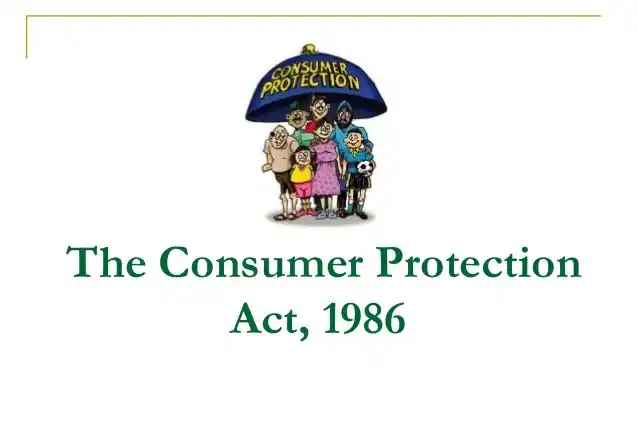National Consumer Day 2024: Empowering Consumers and Promoting Fair Trade Practices
Updated on : 23 December, 2024

Image Source: news18
National Consumer Day, celebrated on December 24 each year in India, commemorates the enactment of the Consumer Protection Act of 1986. This significant legislation established a framework to protect consumers from unfair trade practices and exploitation. The day emphasizes the importance of consumer rights, encouraging individuals to be aware of their entitlements and responsibilities in the marketplace. Various awareness campaigns and activities are organized to empower consumers, promoting ethical business practices and ensuring that they can make informed choices. National Consumer Day serves as a vital reminder of the ongoing efforts to enhance consumer protection in India.
What is National Consumer Day?
National Consumer Day is celebrated in India on December 24 each year. This day marks the anniversary of the Consumer Protection Act, which was enacted in 1986 to protect consumers from unfair practices and ensure their rights. The day aims to raise awareness about consumer rights, such as the right to safety, information, and choice. It encourages people to understand their rights and responsibilities when purchasing goods and services, helping them make informed decisions and promoting fair business practices. Various events and campaigns are organized to educate consumers about these important rights.

Image Source: hindustantimes
The significance of this day lies in its role in educating consumers about their rights and responsibilities while encouraging businesses to adopt fair practices.
Theme for National Consumer Day 2024
Overview of the Theme
Each year, National Consumer Day is celebrated with a specific theme that highlights current consumer issues. The theme for 2024 is yet to be announced, but it is expected to focus on enhancing consumer awareness and addressing challenges posed by digital transactions.
Relevance of the Theme
The relevance of the theme for 2024 will likely revolve around the increasing importance of digital literacy among consumers as online shopping becomes more prevalent. It will emphasize the need for consumers to be aware of their rights in virtual marketplaces and encourage businesses to ensure transparency and security in their online operations.
Historical Background
Evolution of Consumer Rights in India
The evolution of consumer rights in India has been a gradual process influenced by socio-economic changes, legislative developments, and growing consumer awareness. The journey began with minimal protection for consumers and has transformed significantly, particularly with the introduction of landmark legislation aimed at safeguarding consumer interests.
Historical Context
- Ancient and Pre-Independence Era: Consumer protection in India has roots that date back to ancient times, where ethical practices were emphasized in trade. Historical texts indicate that even in the Vedic period, there were norms to protect buyers from exploitation. However, during the British colonial era, consumer rights were largely neglected, with laws favoring traders and leaving consumers vulnerable to unfair practices.
- Post-Independence Developments: After gaining independence in 1947, India recognized the need for consumer protection as part of its commitment to social justice. The Constitution of India, adopted in 1950, laid the groundwork for consumer rights by enshrining fundamental rights such as equality and protection against exploitation.
Key Milestones in Consumer Protection
- Consumer Protection Act, 1986: The enactment of the Consumer Protection Act (CPA) in 1986 marked a significant milestone in India's consumer rights movement. This legislation aimed to provide better protection for consumers against unfair trade practices and defective goods. It established a framework for redressal of grievances through consumer forums at various levels—district, state, and national. Key features included:
- Definition of consumers and their rights.
- Mechanisms for filing complaints and seeking compensation.
- Establishment of Consumer Disputes Redressal Commissions.
- Rise of Consumer Awareness: The 1990s saw a surge in consumer awareness driven by economic liberalization and increased media coverage. This period witnessed the rise of various consumer advocacy groups that educated consumers about their rights and fought against malpractices.
- Consumer Protection Act, 2019: Recognizing the limitations of the 1986 Act, especially in the context of digital commerce and online fraud, the Indian government introduced the Consumer Protection Act, 2019. This comprehensive legislation brought several key reforms:
- Enhanced mechanisms for dispute resolution, including online complaint filing through platforms like 'eDaakhil.'
- Provisions addressing issues related to e-commerce, misleading advertisements, and product safety.
- Establishment of a Central Consumer Protection Authority (CCPA) to promote and protect consumer rights effectively.
Consumer Rights in India

Image Source: bda-skl.in
Right to Safety
Consumers in India have the right to safety, ensuring protection against goods and services that may pose risks to their health or life. This right mandates that products available in the market must adhere to safety standards and regulations, minimizing potential hazards. Consumers are encouraged to insist on quality assurances and certifications, such as ISI or AGMARK, before making purchases. This safeguard is vital in preventing injuries or adverse health effects caused by substandard or dangerous products. The government also plays a crucial role in enforcing these standards through regulatory bodies, ensuring a safer marketplace for consumers.
Right to Information
The right to information empowers consumers by ensuring they receive adequate details about the products and services they intend to purchase. This includes information on quality, quantity, price, potency, purity, and standards. By being informed, consumers can make educated choices, reducing the likelihood of exploitation by sellers. The Consumer Protection Act mandates that businesses provide clear and truthful information, enabling consumers to compare options effectively. This transparency fosters trust in the marketplace and encourages fair competition among providers.
Right to Choose
The right to choose guarantees consumers the freedom to select from a variety of goods and services at competitive prices. This right is essential for promoting healthy competition among businesses, which can lead to better quality products and services. It prevents monopolistic practices and ensures that consumers are not forced into limited options. By having access to diverse choices, consumers can find products that best meet their needs and preferences, enhancing their overall purchasing experience.
Right to be Heard
Consumers possess the right to be heard, allowing them to voice complaints and concerns regarding products or services. This right ensures that consumer grievances are acknowledged and addressed by businesses and regulatory authorities. It promotes accountability among sellers and provides a platform for consumers to seek redressal for issues encountered. The Consumer Protection Act facilitates this process by establishing consumer forums where individuals can present their cases without the need for legal representation, thereby fostering a more responsive marketplace.
Right to Redress
The right to redress entitles consumers to seek compensation for unfair trade practices or exploitation they may encounter. This right is crucial for addressing grievances related to defective goods or inadequate services. Under the Consumer Protection Act, consumers can file complaints with consumer courts or forums that specialize in resolving disputes efficiently. The act aims to provide quick and accessible remedies without extensive legal procedures, empowering consumers to assert their rights and obtain justice when wronged.
Right to Consumer Education
The right to consumer education emphasizes the importance of informing individuals about their rights and responsibilities as consumers. This initiative aims to equip consumers with knowledge that helps them make informed decisions and avoid exploitation in the marketplace. Various programs and campaigns are conducted by government bodies and NGOs to raise awareness about consumer rights. Educated consumers are better positioned to advocate for themselves, understand product information, and navigate complaints effectively, thereby enhancing their overall protection.
Consumer Protection Act

Image Source: slidesharecdn
Key Provisions of the Act
The Consumer Protection Act, 1986 was enacted to establish a comprehensive framework for addressing consumer grievances in India. It introduced a three-tier system of consumer courts at the district, state, and national levels to facilitate the resolution of disputes. The Act empowers consumers with fundamental rights, including the right to safety, information, choice, redressal, and education. It mandates that consumers receive clear information about products and services, ensuring they can make informed choices. Additionally, the Act protects against unfair trade practices and provides mechanisms for seeking compensation for damages caused by defective goods or inadequate services.
Recent Amendments and Reforms
The amendments introduced in 2019 significantly enhanced consumer protection measures. Key reforms include stricter penalties for misleading advertisements and deceptive practices, aimed at deterring unethical behavior by businesses. The amendments also expanded the scope of the Act to cover e-commerce transactions, addressing the challenges posed by digital marketplaces. Furthermore, the establishment of the Central Consumer Protection Authority (CCPA) empowers regulatory authorities to take swift action against violations of consumer rights. These reforms reflect a proactive approach to safeguarding consumers in an evolving economic landscape, ensuring their rights are upheld in both traditional and online marketplaces.
Significance of National Consumer Day
National Consumer Day, observed annually on December 24, holds significant importance in promoting consumer rights and awareness in India.

Image Source: bda-skl.in
Here are the key aspects of its significance:
- Creating Awareness Among Consumers: National Consumer Day plays a crucial role in educating consumers about their rights and responsibilities. It serves as a platform for various organizations and government bodies to disseminate information regarding consumer rights, such as the right to safety, information, choice, redressal, and education. Through campaigns and events, consumers are empowered to make informed decisions when purchasing goods and services, thereby reducing the likelihood of exploitation and enhancing their ability to advocate for themselves in the marketplace.
- Encouraging Ethical Practices Among Businesses The observance of National Consumer Day encourages businesses to adopt ethical practices by highlighting the importance of transparency and accountability in their operations. By reminding businesses of their responsibilities towards consumers, it fosters an environment where ethical standards are prioritized. This not only builds consumer trust but also promotes fair competition among businesses, ultimately leading to better quality products and services for consumers.
- Highlighting the Role of the Consumer National Consumer Day emphasizes that consumers are not just passive recipients but active participants who can influence market dynamics through their choices. By raising awareness about consumer rights, the day encourages individuals to voice their concerns and complaints regarding products or services. This active engagement helps create a more responsive marketplace where businesses are held accountable for their actions, ensuring that consumer interests are prioritized in economic activities.
How is National Consumer Day Celebrated?
- Awareness Campaigns and Workshops: On National Consumer Day, numerous organizations conduct awareness campaigns, workshops, and seminars to educate consumers about their rights under the Consumer Protection Act. These events focus on informing the public about issues such as how to identify defective goods, understand service deficiencies, and recognize unfair trade practices. Educational initiatives often involve interactive sessions where consumers can ask questions and learn practical steps to protect themselves in the marketplace.
- Government Initiatives: Government bodies take an active role during National Consumer Day by launching initiatives that promote consumer education. These initiatives may include the establishment of consumer helplines, outreach programs, and online resources to assist consumers in understanding their rights and the mechanisms available for grievance redressal. Additionally, government agencies may organize public events to disseminate information about consumer protection laws and encourage citizens to report violations.
- Involvement of Consumer Organizations:
Consumer organizations play a vital role in the celebrations by organizing events that foster discussions around consumer rights and protections. They often collaborate with educational institutions and community groups to host forums and debates that highlight current consumer issues. These organizations also advocate for stronger consumer protections and encourage active participation from consumers in shaping market practices, reinforcing the notion that consumers can influence market dynamics through informed choices.
Through these collective efforts, National Consumer Day serves as a significant reminder of the importance of consumer rights and the ongoing need for awareness and advocacy in protecting those rights.
Challenges Faced by Consumers Today
Consumers today face a variety of challenges that impact their purchasing decisions and overall experience in the marketplace. Here are some of the key issues:
- Online Fraud and Cybersecurity Issues: With the rise of digital transactions, consumers are increasingly vulnerable to online fraud and cybersecurity issues. The shift towards e-commerce has led to a surge in cybercrime, including identity theft, phishing scams, and data breaches. Consumers may unknowingly provide personal information to fraudulent websites or fall victim to scams that exploit their trust. As online shopping continues to grow, the need for robust cybersecurity measures and consumer education on safe online practices becomes critical to protect individuals from financial loss and privacy violations.
- Misleading Advertisements: Misleading advertisements pose significant challenges for consumers seeking accurate information about products. Many advertisements exaggerate claims or omit crucial details, leading consumers to make uninformed purchasing decisions. This issue is exacerbated by the prevalence of social media influencers and online marketing tactics that blur the lines between genuine recommendations and paid promotions. As a result, consumers may find themselves dissatisfied with products that do not meet their expectations, highlighting the need for stricter regulations on advertising practices to ensure transparency and honesty.
- Issues with Product Quality and Safety: Concerns regarding product quality and safety remain prevalent, necessitating stringent regulatory measures. Consumers often encounter substandard goods that do not meet safety standards or perform as advertised. This issue is particularly pressing in industries such as food, pharmaceuticals, and electronics, where defective products can pose serious health risks. The lack of effective quality control measures and oversight can lead to consumer distrust in brands.
Role of Government and Consumer Organizations

Image Source: thecro.in
- Role of Consumer Courts: Consumer courts in India serve as essential mechanisms for resolving disputes between consumers and businesses efficiently. Established under the Consumer Protection Act, 1986, these specialized judicial bodies are designed to provide quick and accessible justice for consumers facing issues such as defective goods or deficient services. The consumer court system operates at three levels: the District Consumer Disputes Redressal Forum (DCDRF) for claims up to ₹20 lakh, the State Consumer Disputes Redressal Commission (SCDRC) for claims between ₹20 lakh and ₹1 crore, and the National Consumer Disputes Redressal Commission (NCDRC) for claims exceeding ₹1 crore. This tiered structure ensures that consumer grievances are addressed appropriately based on the monetary value of the complaint, facilitating a more efficient resolution process.
- Initiatives by the Government: The government has introduced various initiatives aimed at strengthening consumer protection mechanisms through policy reforms. These initiatives include establishing consumer awareness programs, enhancing grievance redressal frameworks, and promoting the rights of consumers through public campaigns. The government also plays a crucial role in enforcing regulations that protect consumers from unfair trade practices and ensuring compliance with safety standards. Additionally, the establishment of the Central Consumer Protection Authority (CCPA) under the Consumer Protection Act, 2019, empowers regulatory authorities to take swift action against violations of consumer rights, thereby fostering a more secure marketplace for consumers.
- Contributions of NGOs and Activists: Non-governmental organizations (NGOs) and consumer activists play a crucial role in advocating for consumer rights in India. They engage in various activities such as educating consumers about their rights and responsibilities, conducting workshops, and facilitating grievance redressal processes. NGOs often collaborate with government bodies to promote awareness campaigns that inform consumers about legal protections available to them. Additionally, these organizations may represent consumers in disputes or legal proceedings, helping to amplify their voices in matters concerning unfair trade practices.
Tips for Consumers to Protect Their Rights
How to File a Complaint
To effectively protect their rights, consumers should familiarize themselves with the procedures for filing complaints with appropriate authorities or consumer courts. The first step involves gathering all relevant documentation, such as receipts, invoices, and any correspondence with the seller. Consumers can then approach the seller directly to resolve the issue amicably. If unresolved, they can escalate the matter to consumer courts, which are structured at district, state, and national levels under the Consumer Protection Act. Filing a complaint involves submitting a written application detailing the grievance, along with supporting evidence, to ensure a formal review of the case.
Using the Consumer Helpline
Consumers can utilize helplines established by government bodies to seek assistance regarding grievances. These helplines provide valuable support by offering guidance on how to address issues related to defective products or unfair trade practices. They can help consumers understand their rights and the appropriate steps to take in various situations. Additionally, these helplines often facilitate the filing of complaints and provide information on consumer protection laws, making it easier for individuals to navigate the process of seeking redress.
Staying Informed and Vigilant
Staying informed about consumer rights is crucial for effective protection against exploitation or unfair practices. Consumers should regularly educate themselves about their rights under the Consumer Protection Act and remain vigilant while shopping. This includes checking for proper receipts, understanding return policies, and being aware of misleading advertisements. By being proactive and knowledgeable, consumers can make informed decisions and recognize when their rights are being infringed upon, empowering them to take appropriate action when necessary.
Future of Consumer Rights in India
Emerging Trends
The future of consumer rights in India is increasingly shaped by emerging trends that focus on enhancing digital literacy among consumers. As online shopping becomes more prevalent, there is a growing recognition of the need for consumers to understand digital platforms, their rights, and how to navigate potential risks associated with e-commerce. Initiatives aimed at educating consumers about safe online practices, recognizing fraudulent activities, and understanding their rights in a digital context are becoming essential. Programs like the e-Jagriti portal, launched by the government, aim to empower consumers with knowledge and tools to protect themselves in the digital marketplace.
The Impact of Digital Transformation
Digital transformation is reshaping how consumers interact with businesses, necessitating adaptations in regulations to ensure effective protection. The integration of technology into consumer transactions has introduced new challenges, such as data privacy concerns and the potential for misinformation through AI-driven platforms. As highlighted during World Consumer Rights Day 2024, themes like “Fair and Responsible AI for Consumers” emphasize the importance of safeguarding consumer rights in an increasingly digital world. Regulatory frameworks will need to evolve to address these challenges, ensuring that consumer protections remain relevant and robust as technology continues to advance.
Conclusion
National Consumer Day serves as an essential platform for promoting awareness about consumer rights while encouraging ethical business practices. It highlights the importance of educating consumers about their rights and responsibilities, empowering them to make informed choices in the marketplace. As we move forward into an increasingly digital landscape, it is crucial that both consumers and businesses understand their roles within this framework.
By fostering an informed consumer base equipped with knowledge about their rights, we can create a more equitable market environment where fairness prevails. This collaborative effort between consumers, businesses, and regulatory bodies will not only enhance consumer protection but also encourage ethical practices among businesses, ultimately leading to a marketplace that prioritizes transparency, accountability, and respect for consumer rights.



